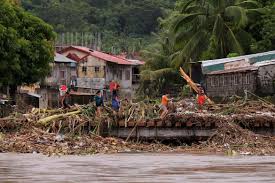
Tropical Storm Trami, also known as Kristine, has wreaked havoc across the Philippines, leaving at least 26 people dead. The storm has caused severe flooding and landslides, particularly in the Bicol region, which has been hit hardest. Many families are now grappling with the aftermath of this natural disaster.
The heavy rains from Tropical Storm Trami resulted in flash floods that swept through towns and villages. As a result, entire communities were submerged, and roads became impassable. Local authorities reported that the flooding was so intense that many people could not escape in time. Tragically, most of the reported deaths occurred in the Bicol region, highlighting the storm’s devastating impact.
According to the government’s disaster-mitigation agency, over 2 million people have been affected by the storm. This figure includes those who have lost their homes and livelihoods. Many families are now seeking refuge in evacuation centers. Currently, around 163,000 villagers are staying in these shelters, where they are receiving food and medical assistance.
In response to the crisis, the Philippine Coast Guard has deployed rubber boats to Naga City. This effort aims to assist stranded residents and deliver much-needed supplies. The Coast Guard is working tirelessly to reach those in remote areas, as many have been cut off due to rising waters.
Furthermore, volcanic mudslides have occurred near Mount Mayon, adding to the dangers posed by the storm. Residents living in the shadow of this active volcano are now at risk from both flooding and landslides. Authorities are closely monitoring the situation, as additional rainfall could trigger more mudslides.
The government has activated emergency response teams to help manage the disaster. These teams are focused on providing aid and ensuring the safety of those affected. Local officials are coordinating efforts to assess damage and deliver relief supplies. They are also urging residents to stay vigilant in case of further weather disturbances.
In addition to the immediate response, long-term recovery plans are being discussed. Community leaders are calling for better infrastructure and disaster preparedness measures. They believe that improvements in these areas could help mitigate the effects of future storms.
International aid has started to arrive as well. Neighboring countries and organizations have offered support to help with relief efforts. This assistance is crucial, as the scale of the disaster is overwhelming for local resources.
As the situation develops, officials continue to urge caution. They remind residents to heed evacuation orders and avoid flood-prone areas. The recovery process will be long, but the resilience of the Filipino people is strong.
Tropical Storm Trami has caused significant devastation, particularly in the Bicol region. With 26 lives lost and millions affected, the community faces a challenging road ahead. However, through collective efforts and support, recovery is possible. The focus now is on helping those in need and rebuilding lives.



